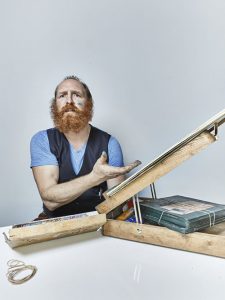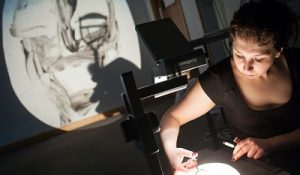The annual August arts celebration in Edinburgh—which comprises the curated Edinburgh International Festival and the wilder, woolier Edinburgh Festival Fringe, as well as a book festival, a fine art fest, and the nightly clatter of the Royal Edinburgh Military Tattoo—is the biggest in the world. Since its modest beginnings in 1947, the fest sends visiting theatre artists home with all kinds of stories—some boasting great reviews, sold-out runs, and unexpected encounters with personal heroes, others nursing complaints about crowded hostels, fruitless busking, bizarre stages, and empty houses. Roving correspondents Eliza Bent and Matthew Love (full disclosure: Both were accompanying loved ones with shows in the Fringe) made the trek this year. Here they tell us where they land on the Fringe pro/con continuum.
MATTHEW LOVE: Eliza, I think you’ll agree that the Fringe is an overwhelming tumult in every way, and it’ll be impossible to tackle it from every angle. But let’s start with general picture. The press office reports that there were 3,269 shows this year; in the week I was there, I saw about 20 of them. I’d never been to Edinburgh—an unbelievably charming city—so I wanted to slow down and take it all in. But what with the deluge of posters, buskers handing out fliers, glowing reviews, recommendations from friends new and old, a show guide thick as an IKEA catalogue, and the nagging sense that theatre was happening whether I snacked, slept, or wandered, I felt nearly crippled by FOMO (fear of missing out). You seemed much more level-headed than I. How overwhelmed were you?
ELIZA BENT: FOMO is so real—I definitely felt it acutely in Edinburgh. But there was perhaps a darker sense of gloom to my fear of not seeing the right thing. You and I established the very particular feeling of overwhelming angst that comes from walking down a spiral staircase plastered in overlapping Fringe posters while in search of a toilet and then closing the bathroom stall only to see more posters for shows. Posterfestunangstenwoe is, I believe, the German expression for this.
Unlike you, who did research in advance, looked things up, and applied for a press badge like a responsible journalist, I went in totally fresh—i.e., unprepared. Did this contribute to my angst? Perhaps. But it also freed my schedule both in terms of popping off for an afternoon nap and in terms of seeing unplanned spectacles. Just as there is Posterfestunangstenwoe, so too there is the lucky, happy feeling one gets when realizing you are at the right show at the right time, and even though the show is sold out according to the chalkboard, there is, in fact, one ticket left—my experience with Rash Dash’s Two Man Show. Let’s call that feeling Lotteryenjoyfeld.
As an audience member, would you go to Fringe again?
LOVE: Yes, I think Lotteryenjoyfeld is that Fringe magic people talk about: the power of possibility, the willingness to be surprised. Against all odds, I nabbed a free ticket to one of the sold-out shows—Kieran Hodgson’s solo, Maestro, a show about Mahler and composing a symphony and love, one of my favorites of the fest—and it felt like a blessing from the Fringe gods. As to whether I’d go back, I’d say absolutely, if I had good excuse.
It feels like it takes time to master the fest, for both performers and audience members. We saw one of my favorite Irish comedians, David O’Doherty, in one of the big Fringe venues, and he mentioned it was his 17th Fringe! Regular Fringe-goers seem to reward the stalwarts.
Other than a travel budget and a long-term commitment to producing new work every year, what do you think an American company needs to make it in Edinburgh?
BENT: I just want to agree big time on this idea of Fringe magic and how rare and wonderful it is to walk into a show with zero expectations! At Two Man Show the audience was positively humming with excitement and the show was sensational and sui generis. Much like our experience with Christeene’s show Trigger, performed in what she calls “the butthole of a castle”—too amazing for words. What a refreshing thing to just turn up to a show and be in the right place at the right time. Regular theatre viewing takes planning: You need to pick a date and time and figure out transportation. A lot of those logistics evaporate when it’s on the fly, Edinburgh Fringe-style.

Another piece that had this kismet feeling, in a very different way, was part of the Free Fringe. I was in a creepy “natural” food store snatching up the free wifi and became overcome and moved by a huckster fliering for Walter DeForest’s Van Gogh Find Yourself. Down into the basement I went and saw a moving and freewheeling portrait of the artist. This show didn’t have the same buzz as certain festival hits like Counting Sheep or Us/Them, probably because it didn’t seem to have the producerial muscle or institutional support of those shows.
To get to your questions: For Americans looking to make the leap, a big question I would ask is: What are your goals in bringing a show to the Fringe? Be honest with the reply. If the idea is to gain notoriety, remember you’re taking a huge gamble. It works for some folks. I was chatting with director Rachel Chavkin’s dad at Everything That Gives Off Light (part of the International Festival, a whole other arm) about the TEAM’s first year in Edinburgh. There were barely any audience members, but the TEAM got a five-star review early enough in the run that it set their trajectory. It was amazing to hear this while seated in a huge sold-out house at a proper venue. I also recall chatting with Dito van Reigersberg of Philadelphia’s Pig Iron, who described how it’s fun to do Fringe in your early and mid-20s when you have tons of energy to get people to your show, but perhaps not as feasible when you are a more mature artiste.
But what do we mean by “making it” in Edinburgh? I bet a group can still do the festival and have a grand time and not necessarily “win,” but I think it’s the rare artist that can step back and have this kind of attitude toward success. (Not to mention the financial pressures and planning that are necessary for the festival.) I think if a group can avoid going into debt and focus on having fun and learning, then sure, do it. Why not?
I’m curious to hear you talk a bit about groups who come back year after year, and the unique funding model that the Baby Wants Candy group has.
LOVE: Yes, agreed, if as a company you don’t want to worry about remuneration and reviews and poster locations and building buzz, go with joy in your heart and you’re golden. You might struggle with light houses, but you’ll undoubtedly meet people you would not have met at home, have adventures, and fly home with a wealth of stories. If you want something more than that, you’ll have to be methodical about achieving your goals and know that you are likely at the beginning of a long journey.
Of course, I don’t think there are a lot of people in theatre because of its overnight successes. And, yes, Chicago’s Baby Wants Candy—this troupe was pioneering, but it has also been persistent. When they went to Edinburgh for the first time in 1998, long before anyone on the international scene had been privy to musical improv, they blew people away. Since then they’ve built an audience and solidified their reputation. Several of the members saw an opportunity to write together and expand their range in Edinburgh, so they assembled and workshopped 50 Shades! The Musical in 2013. It has since run in New York and is still running in Las Vegas. Last year they saw another opportunity and brought Thrones! The Musical Parody to Scotland. (BWC people are smart enough to see commercial potential in certain properties as well as built-in audiences.) They rejiggered it, got even better reviews this year, and sold out their run.
As far as funding is concerned, I think in early years, they did it out-of-pocket because it was fun and they were still locating an audience. At this point, given their fan base and their smartly packaged parodies, they can afford to break even at the fest and make their money with bookings afterward.

Oh, and let’s talk gimmicks! As distasteful as I sometimes find them, Edinburgh definitely reinforced the power of a concise and clever idea to get people in the door. With so many shows, it’s nearly impossible to get the attention of showgoers, so, a quick elevator pitch like, “It’s Madame Bovary retold in PowerPoint” (which was the basic premise of a show we both saw called Infinity Pool) makes it easy to remember and latch onto. As much as this kind of reduction and cleverness might be anathema to a proud artiste, I am convinced that a sticky little piece of information really did motivate me on several occasions. It was a good reminder for packaging and advertising theatre at any level.
Also, how many “impressions” do we think it took to act on things? How many times did you have to read about, hear about, see a poster depicting, or otherwise come across a show before we acted on it? And which opinions were the most valuable to you?
BENT: Gimmicks definitely resonated with me in the noise and hubbub of Fringe. Having reductive descriptions was very useful. Those short descriptions from trusted friends and artists was worth more to me even than the opinions of renowned media outlets like The Guardian. To that end, for me it was a combination of “impressions”: posters seen on the street, in the hallways, and in bathroom stalls, but most of all what I was hearing from peeps I know.

It’s interesting to think about a show I actively resisted seeing (My Name Is Gideon by Gideon Irving), which didn’t have a sound bite I could latch onto. Something about the title didn’t inspire me either, and yet I’m so glad we went to see it! Maybe I’d call it a “charming trunk show by a guy with a great and unusual singing voice who is also kind of a magician”? That feels long if we’re looking for a festival gimmick, and it doesn’t capture the quirk or the poetry of what Gideon is up to, which I believe he will eventually tour across the U.S. on a horse!
Similarly, how would you describe Christeene’s Trigger? The Fringe site called it “a schizophrenic kaleidoscope of ferocious visions and mind-altering jams,” which is pretty close, but I don’t know how that would go over on a flier.
Gimmicks only get you so far. The BWC Game of Thrones musical has such a strong one, and you think you know just what you’re going to get—and you do, with great wigs, amazing accents, and moments of comedy. But it also delivered what was arguably one of the most “experimental” moments I had at the Fringe festival: They sandwiched an unexpected, pure-hearted, uplifting song about the character Hodor into the high jinks, and the payoff, which wasn’t comedic, was nevertheless incredible.

LOVE: Yes, one has to hope a show will be able to deliver on its catchy premise, if not exceed expectations! To return to My Name Is Gideon—something that my lady and I saw and loved, though we did grumble about the curiously opaque title—he comes across like a humble troubadour with a magic trunk, but when you look at his program, he’s got an entire team of producers and staff behind him! So even relatively small, outside-the-box shows benefit from going beyond the romantic, DIY ideal. As far as self-proclaimed “drag terrorist” Christeene goes, I could write an essay collection; suffice it to say I was shocked, titillated, grossed out, and oddly touched by this burned-out tween pop icon reborn in the body of Iggy Pop.
Last thing: Would you do anything differently if you went next year? I’d definitely go at the beginning of the fest, before everyone is exhausted and public opinion has not coalesced around certain shows, making tickets hard to come by—and I’d do even more research to get a sense of which performers and companies are on the rise. The rest, I’d leave to Fringe magic.
BENT: I liked going toward the end of the festival, because the already formed public opinion helped me choose what to see. I would also bring an eye patch to avoid Posterfestunangstenwoe. Otherwise I’d ride the magic fringed carpet.
Playwright/performer Eliza Bent is a former senior editor of this magazine. Matthew Love is a writer and sometime improviser based in Brooklyn.
A version of this story appears in the November 2016 issue of American Theatre.


